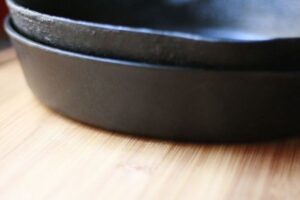How to Clean a Crusty, Rusty Cast Iron Skillet

If you were to write out the pros and cons of cast iron, the list would likely lean heavily on the pros side. Cast iron is sturdy and durable. It can even handle the heat from the open flame of a campfire. If properly cared for, cast iron will last a lifetime or even past your grandchildren’s lifetimes.
As far as cookware goes, not much can top it. Cast iron conducts heat evenly. With cast iron, you can start off a casserole or frittata on the stove and finish it off in the oven. It won’t gas off any noxious chemicals, like nonstick cookware does. With time (and use) your cast iron skillet will actually make your food taste better.
Does this longtime favorite cookware have any negatives? Well, if it’s not used for a while, or if it’s regularly exposed to water, it can start to rust. Stuck on or burned on food also makes cast iron skillets a bit tricky to clean.
Some cast iron cleaning tutorials suggest you use oven cleaner or all-purpose cleaners to clean a particularly crusty cast iron skillet. Don’t worry. You don’t need anything near that toxic. You mostly just need a potato…and a couple of other items, but really just a potato. Cool, huh?
Cleaning your skillet
Materials
Raw potato
Kosher salt
Oil
Directions
1. Set your cast iron skillet in the sink and sprinkle a teaspoon or two of Kosher salt in the bottom.
2. Slice off the top of a raw potato. Make sure to leave enough of the potato so you can grab it easily. Use the cut end of your potato to scour the skillet, grinding the salt into any rusty or crusty spots. As you work, rinse off the skillet (and rust!) and add more salt if it requires more scrubbing.
3. Once all of the rust has vanished (Yay!), dry your skillet with a clean towel.
4. If you don’t need to re-season your skillet, just add a few drops of oil to its surface. You can be a tad heavy handed with the oil, as it will mostly just absorb. Rub the oil into your skillet’s surface, that way it’s ready to go for you next cooking adventure.
Seasoning your skillet
Seasoning your skillet will make its surface just as slippery-good (and likely better) than the surface of a nonstick skillet. To season your pan, simply coat it liberally in oil (olive, sunflower, canola). Heat your oven to 350 degrees. Let your skillet roast for about an hour in the oven, then turn it off. Go to sleep. When you wake up you’ll pull out a shiny, freshly coated skillet with a gorgeous black patina from the oven.
Caring for your skillet
Never, ever, ever wash your skillet with soap again. Don’t even let a drop near it. The soap will wear off your fresh coating of oil and it will likely make your next meal taste a tad sudsy. After you finish cooking with your skillet, immediately rinse it out to remove any burned on bits. If you need more scrubbing, let it cool, and then use salt and a coarse scrubbing pad to get rid of any burned bits. Don’t let your skillet soak for long periods of time, and never put it in the dishwasher.
Follow Kirsten on Twitter @kirsten_hudson, Google+ and Pinterest.
image: cinnachick

